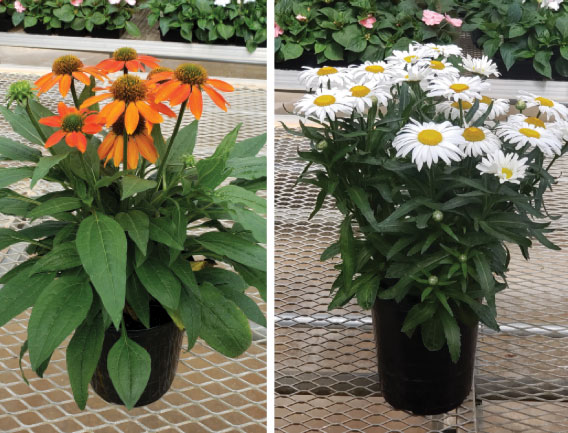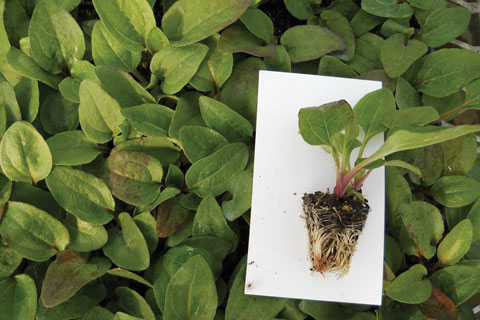9/1/2019
Perennial Seed Success
Chris Fifo

The world of perennials has been evolving very quickly. Advancements in breeding is bringing new and improved products to market at a record pace.
Much of this has been hitting the market in the way of vegetative propagation: tissue culture and unrooted cuttings. All it takes is one plant, one selection with amazing attributes, to make it into the market. Hence, the record pace.
Pictured: Far left—A new, premium echinacea coming soon from Kieft Seed. • Kieft Seed’s new, first-year flowering leucanthemum, Madonna.
What about perennials from seed? This can be a much more cost-effective alternative to vegetative propagation. These lower input costs can lead to greater margins for growers.
New perennial varieties from seed don’t make it to market nearly as quickly as their vegetative counterparts; this process can take years to develop stable genetics, consistent performance and vigorous seed. If the process is taken even further to develop an F1 hybrid (greater consistency, improved performance), it takes even longer. Some of the newest releases from Kieft Seed have been 10 years in the works!
So new perennials from seed don’t come to market as quickly or in the numbers that vegetative does. But when they do, they’re pretty amazing.
Here, I’d like to focus on some details of just a few primary classes of seed perennials.

Echinacea
These can be challenging. Sow one to two seeds per cell into a 288. A slightly recessed or dibbled plug tray is preferred, allowing for a light covering of the seed without media or vermiculite covering the surface of the tray. Germinate seeds at a constant 70 to 75F (21 to 23C). Pretty straight forward.
Pictured: If purpling is observed on echinacea leaves, make sure temperatures are above 65F (18C) and use a higher phosphorous feed.
The critical factor for echinacea germination is moisture. Not too wet. I prefer the plug trays go into the germination area at a 4.5 for moisture. (If you’re not familiar with the 1 to 5 watering scale: 5 is saturated, 3 is on the verge of turning light brown on the surface, 1 is near wilt.)
A 100% humidity germination room is not ideal for echinacea. After the first 48 hours, the trays have to begin to dry down. By Day 3, the seeds have absorbed as much moisture as they need for germination and trays should be maintained at a 3 to 3.5 to avoid losses and poor uniformity. By Days 7 to 9, germination should be complete.
An alternative method I’ve used when I was struggling with maintaining the proper moisture was to germinate the seeds uncovered. This way, they could tolerate a higher humidity chamber (though not saturated) without being overly wet from covering. And I could see what’s going on with the seed. When germination was complete (cotyledons beginning to develop), I would then add the normal amount of media or vermiculite covering, leaving the cotyledons exposed and the ribs of the plug tray visible.
For growing on, I’ve always believed if you avoid the extremes in temperature and moisture, you can avoid the majority of problems in most crops. Echinacea are no different; they like to be grown on the warmer (65 to 75F/18 to 23C) and drier side.
Echinacea prefer a pH around 6.2 to 6.5 and Cal/Mag type fertilizers such as 15-5-15. Begin feeding after germination is complete with 75 to 100 ppm. Feed can be continuous at a lower rate, but I prefer feeding twice a week with clear water in between. Increase feed to 150 to 200 ppm as needed for growth.
Of particular note with feed: If purpling is noticed on the lower leaves, it can be a sign of phosphorous deficiency. If left alone, the symptoms can progress and become very unsightly. Switching to a higher phosphorous fertilizer, such as 20-10-20, will prevent further symptoms.
My theory on feeding plugs has always been “you are what you eat.” The more you can feed, and manage moisture, the more bulk you’ll have. However, we need to control the top growth.
A combination of B-Nine (3,750 ppm) and Cycocel (500 ppm) works very well as a spray. The first application can be made as the crop has consistently developed the first true leaf. After this, it can be applied as needed. Sometimes it’s every two weeks. If necessary, something stronger like uniconazole (Sumagic, Concise) can be sprayed at 3 to 5 ppm.
Echinacea have a photoperiodic response for growth. Under long days, they’ll grow fast and upright, often requiring more PGRs. Under short days, they grow much more slowly.
The best way I’ve found to grow these is under long days until about Day 28. Then I move them to short days and feed them heavy for five weeks until finish. This gives me strong initial growth, but then slows and stacks the leaves for the remainder of the crop cycle. This long-day/short-day approach has an additional benefit with the Kieft Echinacea in particular. If the plugs are grown to a minimum of seven leaves under short days and then transplanted into long days, they’ll flower very uniformly the first year. No cold treatment required.
Coreopsis
Coreopsis are very similar to echinacea for germination and growing on:
• Require a light covering (I prefer media for a cover because I can tell when the plug tray is dry, as opposed to vermiculite that dries before the media)
• Germinate at a 3 to 3.5 moisture after the first two days; too wet and germination is lost
• Germination is usually complete by Day 7 at 70F (21C)
• pH 5.7 to 6.2
• Grow on the warmer and drier side
• Cal/Mag type feed, but not as heavy of a feeder under long days
Coreopsis are also photoperiodic for growth. They’re difficult to control with PGRs under long days. Uniconazole is effective at higher rates, but I have concerns with using higher rates in the plug stage. Weekly sprays of B-Nine/Cycocel are preferred. With a short-day photoperiod, coreopsis grow more rosettes and can be fed heavy without the need for PGRs. Plugs are generally ready for transplant in seven weeks.
Lavender
Lavender are nearly a no-brainer growing from seed:
• Two to three seeds per cell
• No covering
• 65 to 75F (18 to 23C); 4.5 to 5 for moisture
• Germination is complete by Days 5 to 6
• pH 5.7 to 6.2
• Prefer Cal/Mag type fertilizers that promote toned growth
The key point about growing lavender is to avoid excessive and soft growth that can lead to Botrytis and Rhizoctonia. High light, low humidity and good air flow are beneficial. As for PGRs, B-Nine at 2,500 ppm can tone these nicely until they’re ready for transplant in about seven weeks.
Leucanthemum
Leucanthemum can be a bit challenging early on, but finish easily:
• Two to three seeds per cell
• No cover
• 65 to 75F (18 to 23C); 4 for moisture
• Germination is complete by Days 5 to 6
• pH 5.7 to 6.2
• Any standard fertilizer formulations work well
Germination isn’t difficult, but leucanthemum cannot be germinated saturated—the slightly larger, soft seeds can absorb too much water and cause losses. It’s okay for the media moisture to be higher at a 4.5 as long as the humidity is around 80%, allowing the seed and media to dry slightly by Day 3.
Growing on is relatively easy with no exceptional pitfalls other than occasional leaf spot. 5 ppm of A-Rest at the first true leaf stage can be very effective, or uniconazole at 2 to 4 ppm can be used as needed later in production. Plugs can be fed heavy in the later stages and are ready to transplant in about six weeks.
As you may have noticed, perennials aren’t nearly as picky about temperature as they are about moisture for germination. With proper moisture management, anyone can increase their profitability with the latest and greatest perennial genetics from seed. GT

Chris Fifo is a Product Representative for Darwin Perennials and Kieft Seed.